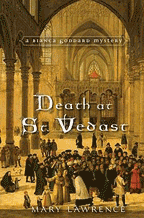Exclusive interview with author Mary Lawrence on her new novel set in Tudor London, a murder mystery centered a lady accused of witchcraft.
By Gabrielle Pantera
“My agent suggested I write a story where Bianca is accused of witchcraft,” says Death at St. Vedast Mary Lawrence, author of the popular Bianca Goddard mystery series.
 “Reading about the Salem Witchcraft trials and the latest theories behind them gave me an idea. Usually I start with a malady that intrigues Bianca and also affects someone in her personal life. When I realized how heavily Tudor citizens relied on bread as a food staple, I knew that could be used as the causative agent. St. Vedast Church became the natural choice for where the story is centered. I could link its patron saint to the story line. St. Clement, the patron saint of the Bakers’ Guild.”
“Reading about the Salem Witchcraft trials and the latest theories behind them gave me an idea. Usually I start with a malady that intrigues Bianca and also affects someone in her personal life. When I realized how heavily Tudor citizens relied on bread as a food staple, I knew that could be used as the causative agent. St. Vedast Church became the natural choice for where the story is centered. I could link its patron saint to the story line. St. Clement, the patron saint of the Bakers’ Guild.”
The novel opens in Tudor London, where Bianca Goddard’s husband John supports her learning alchemy. She seems to be able to both kill people or save them. The couple’s friend, the silversmith Boisvert, is set to marry the wealthy widow Odile at the local St Vedast’s church. But before the ceremony the body of a woman is found under the church bell tower. And when Odile dies suddently at the ceremony, throwing suspicion on her new husband, Bianca is determined to prove his innocence…..using alchemy, a dangerous plan.
“After I finished the second book in the Bianca Goddard mystery series, I needed time to resolve the character arc of a key character,” says Lawrence. “But, the deadline for book three was ticking away. Because I hadn’t decided what to do with him, I needed to get Bianca out of Southwark and away from his influence.”
“Boisvert the silversmith had a shop on Foster Lane in Aldersgate ward,” says Lawrence. “I learned that the area was home to several guilds and three churches. The bread idea led me to read more about the Worshipful Company of Bakers and their infighting. I used a rivalry between the various guilds to link guild members to the murder. This gave me the idea for the villain’s demise. The symbolism synced beautifully with the storyline.”
Lawrence, who was a science major in college, say she didn’t get to take the literature and history courses that I wanted to there. “Top on my list was learning more about Shakespeare’s works. I started reading his plays and became smitten with his use of language and humor. The series grew out of my love for Tudor history and my interest in science and its beginnings. It seemed natural to combine the two topics I loved to read about into a fictional world.”
Lawrence says she loves researching and reading. “I spent a lot of money ordering books for Death at St. Vedast. I needed to know about London guilds so I read 1666 and All That about the Baker’s Company, and I read The Early History of The Goldsmith’s Company. Eamon Duffy’s The Stripping of the Altars and The Voices of Morebath helped me understand religious beliefs in the sixteenth century and the changes that occurred because of the Reformation. When Death Do Us Part and Women’s Voices in Tudor Wills helped me with probate laws and testaments. A Survey of London, by John Stow, and London: The City Churches were helpful regarding church history and locations. I also rely on the Map of Early Modern London, the Agas Map and The A to Z of Elizabethan London for place names and for moving my characters through the city.”
Lawrence has signed with Kensington Books for another two Bianca Goddard mysteries. She’s currently writing the fourth book, where Bianca risks her life and that of her unborn child to save her husband.
Lawrence lives in rural Maine, near Portland at the foothills of the White Mountains. She was born and raised in southern Indiana.
Death at St. Vedast (A Bianca Goddard Mystery) by Mary Lawrence. Trade Paperback, 304 pages. Publisher: Kensington (December 27, 2016), Language: English, ISBN: 9781617737145 $15.00
